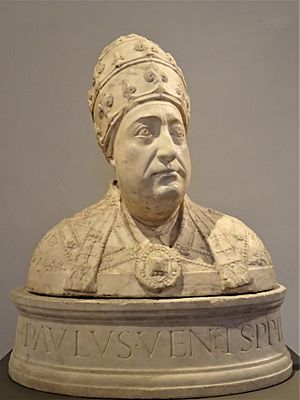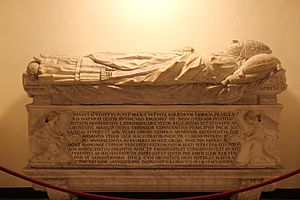Pope Paul II facts for kids
Quick facts for kids Pope Paul II |
|
|---|---|
| Bishop of Rome | |

Contemporary bust of Paul II by Mino da Fiesole, now in the Palazzo Venezia
|
|
| Church | Catholic Church |
| Papacy began | 30 August 1464 |
| Papacy ended | 26 July 1471 |
| Predecessor | Pius II |
| Successor | Sixtus IV |
| Orders | |
| Created Cardinal | 1 July 1440 |
| Personal details | |
| Birth name | Pietro Barbo |
| Born | 23 February 1417 Venice, Republic of Venice |
| Died | 26 July 1471 (aged 54) Rome, Papal States |
| Previous post |
|
| Other Popes named Paul | |
Pope Paul II (born Pietro Barbo) was the leader of the Catholic Church and ruler of the Papal States from 1464 until his death in 1471. He was born on February 23, 1417, and died on July 26, 1471.
Pietro Barbo was the nephew of Pope Eugene IV. When his uncle became pope, Pietro changed his career path from being a merchant to studying religion. He quickly rose through the ranks of the Church. As pope, Paul II became famous for collecting a large amount of art and ancient items.
Contents
Early Life and Church Career
Pietro Barbo was born in Venice. His mother, Polixena Condulmer Barbo, was the sister of Pope Eugene IV. Because of his uncle's influence, Pietro's career in the Church moved very quickly.
He became an Archdeacon in Bologna and a Bishop in Cervia and Vicenza. In 1440, he was made a cardinal-deacon. Pietro was known for being very generous, which made him popular.
In 1445, he became the archpriest of Vatican Basilica. Pietro Barbo was very important during the time of Pope Eugene IV, Pope Nicholas V, and Pope Calixtus III.
Becoming Pope
Pietro Barbo was chosen to be the next pope on August 30, 1464. He was elected by a majority of the cardinals present. Some cardinals were not happy with the previous pope, Pope Pius II, which helped Pietro get elected.
When he became pope, Paul II was supposed to hold a major church meeting within three years. However, he changed these plans. This made some cardinals lose trust in him because they felt he was trying to gain more power.
Paul II became less accessible after his coronation. He often granted meetings only at night. He also became very suspicious of others. He had a special papal crown made for himself. It was covered with many precious gems like diamonds, sapphires, and large pearls.
He built a large palace called the Palazzo San Marco (now known as the Palazzo Venezia) in Rome. He lived there even as pope and filled it with a huge collection of art and ancient artifacts.
Challenges and Conflicts
Paul II sometimes appointed new cardinals secretly without telling everyone their names. He wanted to increase the number of cardinals who supported him. In 1467, he appointed eight new cardinals, including some suggested by kings from different countries. He also appointed two of his nephews as cardinals.
One major issue was when Paul II decided to get rid of a group of officials called the Abbreviators. These officials were responsible for writing papal documents. Many educated people, including writers and poets, worked in these positions. When Paul II removed them, it caused a lot of anger.
He also took action against the Roman Academy, a group of scholars. Bartolomeo Platina, a member of both the Abbreviators and the Academy, lost his job. Platina wrote a strong letter asking the pope to change his mind. Because of this, Platina was put in prison for four months.
Later, in 1468, Paul II arrested Platina and other members of the Roman Academy. He accused them of not being religious, acting immorally, and even planning to harm him. The prisoners were questioned and eventually released.
After his release, Platina wanted to work for Paul II again, but the pope refused. Platina then wrote a book about the lives of popes. In this book, he described Paul II in a very negative way. For a long time, this book influenced how people viewed Paul II.
This conflict had a big impact on the intellectual life in Rome. Scholars realized that the pope expected them to follow certain rules. After Paul II's actions, the Roman Academy started to focus more on religious studies.
Final Years and Legacy
Pope Paul II had a disagreement with George of Poděbrady, the King of Bohemia. The king supported certain church ideas that Paul II did not agree with. In 1465, Paul II called King George to Rome, but the king did not come. The pope then sided with those who opposed the king in Bohemia. In 1466, he officially removed King George from his position.
Paul II died suddenly on July 26, 1471, from a heart attack. Some reports said he had eaten too much melon. His death created a power shift in Central Europe, especially since King George had also died earlier that year.
Even though Paul II was not a big supporter of humanist learning, he allowed printing to be introduced into the Papal States. The first printing presses were set up in Subiaco in 1464 and in Rome in 1467. This meant that books became much more common and cheaper than handwritten copies. Printing helped more people, including those not in the Church, get access to education.
Paul II also cared about public entertainment. In 1466, he allowed horse races to be held on the main street of Rome during Carnival. This street became known as the Via del Corso. He even organized races for boys, men, older people, and Jewish people, with prizes for each group. He also tried to reduce fighting between families in Italy and ensure that Jewish people were treated fairly.
Paul II loved showing off his wealth and importance. After he died, his successor, Pope Sixtus IV, found a huge treasure. It included silver containers filled with pearls, jewels, and gold, all worth a lot of money. He also had a collection of 800 gemstones.
Some historians believe that Paul II was misunderstood by the Italian courts. They thought he was an honorable man. In terms of ruling, Paul II did not achieve much for Italy as a whole. However, in his own lands, he ended the rule of the Anguillara family in 1465.
Images for kids
See also
- Cardinals created by Paul II
- In Spanish: Paulo II para niños




